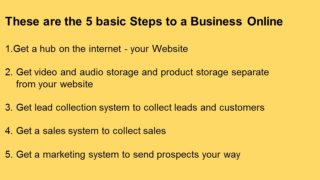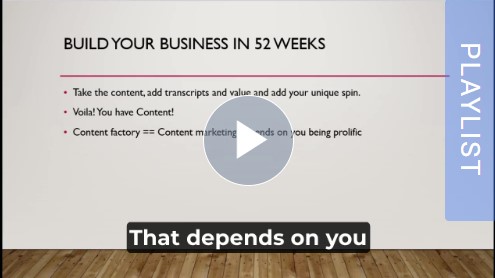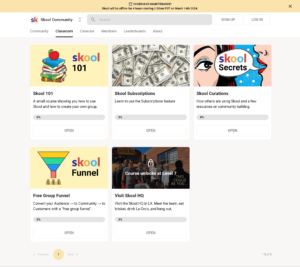It’s Fun to go back to Skoool!


Are you looking to build authority, trust, and credibility in your niche?
You are?
Excellent. Then you probably know that you need a loyal audience of people who will eagerly consume your content and buy whatever you create or promote.
But here’s the problem!
We live in an information age where people are bombarded with content, non-stop notifications, social media drivel, and a plethora of other distractions.
Building a solid community is only half-the battle… keeping them engaged and interested is the other half – and it’s the more important and difficult half.
While several solutions have popped up on the marketplace to address this problem, there’s on exceptionally outstanding platform called Skool that does this brilliantly…
And we’ll look at it in more detail further down.
What’s important now is that you understand why you need a community…
Why Every Marketer Should Be Building a Community (Tribe)
Having a community ensures that you are in constant contact with your audience/customers. This is imperative not only for trust-building… but for the survivability of your business.
Building a reliable community is key to boosting repeat sales, conversions, and recurring income.
A community could be a Facebook group, a server on Discord or a cool niche group on Skool.
While each has its pros and cons, the underlying principle is the same – there’s a place for your audience to hang out and interact with each other.
Word-of-Mouth Marketing
When you have a group, it’s inevitable that some members will help others and if your courses/training are good, they’ll recommend what worked for them. This social proof and brand advocacy will lead to higher conversions and increased sales for you.
* Feedback
With a community, you’ll be able to get feedback on your products/training. You could conduct polls, ask for suggestions, etc. You’ll gain a better grasp of what your audience truly needs… and you can serve them better.
* Increased Loyalty and Retention
When you’re present in a group and interacting with your members, you’re no longer a vendor who sells from a distance. You’re now a friend – and people love interacting and supporting their friends.
We could go on and on about the benefits of having your own community, but you get the idea.
What you probably want to know is…
“How and where do I host my community?”
This Is an Excellent Question!
But it’s not so easily answered because several variables are involved.

Up until now, Facebook groups were seen as the ideal way to build a community. The fact that they’re free to set up and most people are already hanging out on Facebook works in the platform’s favor.
Aack!
However, there’s a very insidious side to Facebook – the platform itself is designed to distract your audience with ads, other posts, and a ton of other ‘interruptions’ – that make money for the platform.
If you’re not paying for the product, then you are the product… and the currency is your attention… and your subscribers’ attention.
Their focus is NOT on helping you win. Facebook looks out for Facebook. Period.
So, while you could build a tribe on Facebook, you’ll want to funnel your audience to a group on a platform like Skool where you control things in your group.
Everything will be more focused on your content, your offers and your messaging.
The Most Popular Platforms…
There are several platforms like Discord, Circle, Teachable, Kajabi, etc.
We looked at most of these and after weighing the pros and cons, there was just no denying that Skool was far superior to all the rest.
Created by marketing legend, Sam Ovens, this structured platform is designed to minimize distractions while offering excellent course and community features.
So while you could go around looking at the other options, you’ll soon discover that nothing comes close to Skool at the moment.
The fact that another popular marketer, Alex Hormozi, has been raving about it in his YouTube videos is only going to increase Skool’s popularity.
We’re hoping they maintain their relatively low (straightforward) pricing as demand increases. It’d be better to get in early while you can.
Now let’s weigh the pros and cons of Skool.
Why Skool is the ONLY Course Platform You’ll Need
If you’re planning to build a community with the products/courses you’re selling, here’s why Skool helps…
It’s Easy to Use
This platform is extremely simple to navigate and set up.
Even the greenest of beginners will be able to create, host and sell their courses here and create a lively community.
With the drag-and-drop editor, you won’t need coding knowledge or anything complex.
The learning curve is short, gentle, and fun.
All-in-one-platform
Skool is an all-in-one platform… and your customers/members will find it just as easy and intuitive to use.
Unlike Discord which seems clunky and confusing to navigate, Skool is a breeze and looks a lot neater.
* Community Engagement
Why else would you use Skool if not for this awesome feature?!!
Your students will be able to hang out and engage with each other in your group (on Skool).
Interacting in a Skool group is very similar to what you’d do on Facebook. You can post videos, gifs, comments, likes, etc. and it all updates in real-time so everything stays ‘active’ and fluid.
As the leader of the group, you’ll be able to engage with your members by chatting with them and even message members privately, if you want to.
****
Even more important, members can develop relationships with other members because there is direct messaging available for them too! Your group could get known as a place for members to collaborate and partner on ventures with little intervention by you!
* Built for Digital Course Creators
This reason is definitely why so many course creators are switching to Skool. It’s designed to make it easy for vendors to focus on teaching and selling their infoproducts.
As mentioned earlier, you’ll be hosting your courses on Skool. So there’s no need to build a separate course website and connect a whole bunch of complicated plugins. Everything can be done in minutes!
Search Function
The unified search function will allow you to find comments, posts, members from one place quickly.
Broadcast Emails
You’ll be able to send broadcast emails to your members too. So it has some degree of email marketing feature – though it comes nowhere close to a solid autoresponder such as ConvertKit. So you may want to invest in a separate email marketing tool.
*****
I am in three Skool groups. What I love is I can set up a weekly digest email to come into my Inbox every week to see what's happening and even more important, I can click on button in email and go to the group to add my comments or observations! Unlike the Facebook notification that push onto your monitor while you work, you can look to see what's happening in your groups in your email provider when YOU are ready!
Payment Processor
Skool also has payment processing integrated into it. You can accept payments through Stripe and PayPal.
It you wish to use other integrations, Skool works well with Zapier… and you can contact their support for further advice related to your needs.
* Awesome Classroom Features
The learning management system in Skool is just as good (maybe even better) than most platforms such as Kajabi, Teachable, and even LMS plugins.
It has all the features you’ll need: modules, lessons, progress tracking, transcripts, etc.
The greatest advantage Skool has is that it integrates the community building with the courses flawlessly. Everything is smooth and works synergistically.
So your students are not only consuming your content, but also engaging at the same time. It’s a win-win for everyone.
* No Ads… No Distractions
Unlike Facebook which bombards its feed with ads, there are no ads in Skool.
No one is going to be distracting or ‘stealing’ sales/customers from you. This point alone makes Skool a clear winner in our books.
* Event Calendar
It’s easy for members to forget group events and so on. Thankfully, Skool has an event calendar feature that’s prominently displayed so your members are always on track and reminded of any upcoming events.
* Gamification Features
When it comes to selling courses and building a community, Skool’s closest competitor is probably Circle.
But while Circle is priced slightly cheaper (which makes it more attractive to those on a budget) … it lacks the superior gamification features found on Skool. So your students will not have as much fun consuming your content, if you were on Circle.
* What is Gamification?
Gamification features include points, badges, leaderboards, and levels, which aim to motivate users through game-like elements.
The hard truth is that most students who sign up for a course, despite paying for it, will drop off halfway. That’s just the way things are.
With gamification features that enhance engagement, encourage participation, and foster a sense of accomplishment – you’ll not only be able to keep the student motivated, but they’ll be more likely to finish what they start.
Skool’s gamification features such as points, leaderboards, activity tracking and so on are excellent for keeping your tribe hooked on your training.
******
In the Skool groups I am in, they use gamification to keep us coming back to participate. If I make a post asking a question, I get so many points; if I make a comment on a post, I get so many points and there is a leaderboard showing who does the most comments, posts etc. With Skool, you can even open a course in your community depending on how many points a person gets, they can get a new course to watch!
* Detailed Analytics
Skool has a metrics dashboard that will show you how your students are progressing, what their favorite modules are, how many students you have within a time range and so on.
By looking at the numbers, you’ll be able to ascertain the health of your group and what type of content works best.
It’s all laid out easily. So you won’t need a PhD in calculus to understand your stats.
* 24/7 Support
When it comes to customer support, Skool is excellent. The only other platform that seems to have faster support is Systeme.io.
But the key takeaway here is that if you ever need help, Skool’s support is always there to assist you at any time of day.
* Free Courses
Skool has a few free courses for you to enroll in so that you understand how to use the platform well.
These invaluable courses will help you get the best out of Skool and help you sell more subscriptions.
* Affordable, Straightforward Pricing
Some platforms like Kajabi offer a myriad of features (most of which you won’t use) … but they charge an arm and a leg.
Skool is a lot more affordable and charges a flat rate every month. The pricing plan is very simple. You pay one fee and get ALL the features.
You get unlimited courses, unlimited students, no hidden fees – and you can cancel at any time.
Skool’s transaction fees are the lowest when you compare it to its competitors!
* 14-Day Free Trial
Still on the fence?
Give Skool a 14-day spin and see if it’s right for you. Our guess is that you’ll never look back. There is zero risk for you here.
Disadvantages of Skool
For the most part, we were highly impressed with Skool, but it would be remiss not to discuss the disadvantages – and there are few.
* Platform Dependency
If you host all your courses on Skool, you’ll need to keep paying the monthly fee. If you stop paying, you’ll forfeit your account and your tribe on the Skool platform.
Similarly, if you decide to move to another platform, it’ll be a hassle to move all your courses and members to a new platform. While this is not a deal breaker and is mostly true for any SAAS service, it’s still something to be aware of.
The good news is that Skool and the people behind it are legit and reliable. The platform is skyrocketing in popularity and should last a long time.
* You’ll Need to Find Your Own Members
While you’ll see several popular groups displayed on the home page of the Skool website, the truth is that you’ll need to find your own members, customers, etc.
Skool is an excellent platform that hosts courses and communities. But it’s just a ‘tool’.
Ultimately, your success in making your business work will rest squarely on your lead generation and sales skills.
Don’t expect Skool to make you an overnight millionaire, despite the hyped-up content and fanfare you may come across online. You still need to do the work.
* Beginners May Find the Pricing Steep
If you’re a successful marketer, forking out $99 a month is not an issue. For a beginner who’s just starting out, this monthly fee can feel like a burden.
The best way to remedy this issue will be to sell a few courses first and gain traction. With an email list, you’ll be able to do remarketing and get more repeat sales.
Once your course sales cover the monthly Skool fees, then you can leverage the 14-day free trial and go on to pay for it.
Baby steps here.
* Facebook is still an unconquerable behemoth (for now).
While Skool is a far better course platform and has much more community engagement features… when it comes to traffic, it’s absolutely no match for Facebook.
That’s just the hard truth.
Most people do not consciously choose to use Facebook. It’s an almost subconscious habit for them to reach for their phone and scroll on social media.
They’ll read whatever posts appear on their feed, including the group posts… which have limited reach.
On the other hand, it’ll take a conscious effort to get your tribe to log into your Skool group to consume your content. It’s not a habit for them.
The best way to remedy this problem will be to have a Facebook (FB) group and ask your Skool members to join that too.
Then you could post teasers of your latest/upcoming content in your FB group and have a link pointing to your Skool group. Now, your tribe that’s doom scrolling on FB will see your post and be more likely to see what’s in your Skool group.
You’ll also want to add your Skool members to an email list so that you can email them about new content, events, etc.
When you can reach them on multiple platforms, you’ll get them to repeatedly visit your group more easily. This will always be a bugbear when it comes to using Skool, because using the platform is not a mainstream habit.
So extra effort will be required to get them inside and engaged.
Should You Sign Up with Skool?
A definite yes.
If you’re a marketer selling your own courses… building a community is not an option, but a necessity.
It’s the surest way to build and maintain a connection with your tribe. It’ll also ensure business longevity while creating brand awareness and trust in you and your products.
Feature-wise, Skool is all you’ll need to sell courses and build a community.
Everything on Skool will take your course business to the next level.
There’s no risk for you here. With the 14-day free trial, you have nothing to lose.
Give Skool a try and you’ll be amazed at how easy it is to set up, sell on and charge monthly fees.
Nothing like recurring revenue from an engaged community to boost your bottom-line and skyrocket your profits.
Try Skool today and you’ll be glad you did.
>> Try Skool Now! <<
Are you Working IN your Business or working ON your Business?


Are you working IN your business or ON your business?
One of the biggest reasons that "business systemization" is so important is that it allows you to step out of your business and focus on ways to make it better. Often we are too concerned with working in our business that we stop working on them- and when we allow this to happen it can often represent the start of a vicious circle and a road to nowhere!
How does business systemization help?
If you are someone who is working in your business, you start each day with a long to-do list and work through it till complete and you start again the next day! You are only managing the workload instead of having some time to think of new direction or new ideas for your business.
If you are working on your business, you have more time for research and development. You are looking for potential future markets to go into and/or forecasting profits for the business. You are finding new ways to grow and expand rather than maintaining the status quo.
How to get to work on your business?
You should be working on increasing your profit and decreasing the amount of time you are working on it. Either way, you are improving your position and that's the point of a business.
Business systemization helps you to get to working on your business because you hand over some chores in your business to automation or staff so you can concentrate on future planning and profit growth.
You won't be constantly putting out fires in your business because you will have systems that automate tasks or staff that can handle the fires and they know what to do to put them out.
Business systemization makes your business more efficient and that means your business can grow and/or you can step back from the chores of doing business. Recognizing and developing systems in your business can lead to a more fulfilling business and life balance.
For more on the 5 systems you need to have an internet business, you can check out my free training, the Five Systems you need in your business here.
Digital Marketing or Affiliate Marketing Pros and Cons

The Digital Product vs. Affiliate Business Method
Which Business Model will fit into your Lifestyle?
When starting an online business, many newbies can’t decide on the business model which will fit their lifestyle while making them revenue. When starting a business, the decision often boils down to two options – promoting other’s products or selling their own products.
There are definite pros and cons to each one, and some of that is based on your own personal skills and preferences. But other aspects of your decision will be based on things like profit potential, ease of implementation, and even the speed with which you can earn.
There are some new things that have changed in the marketplace in recent years making it easier than ever for people to choose either of these methods for their business – or, combine them into one lucrative option!
Below, we’re going to go over some things that might sway your mind to select one over another, and help you start off on a path that will not only be profitable, but personally fulfilling as well.
How Fast You Can Get Your Money
There’s a big difference between how fast you can earn money and how fast that money is deposited in your bank account. We’re starting off with this point, because for many (if not most) people, the desperation they feel in needing to get paid is palpable.
In order to calculate the speed with which you can earn, several factors come into play. For example, as a digital vendor of products like eBooks or video courses, you have to factor in the product creation time and whatever amount of time you want to spend recruiting affiliates.
This is going to vary for everyone because it takes some people months to create products and others a few hours. It’s feasible for some people to come up with a product idea, create it in a day, tell affiliates about it and start having money in their PayPal or Stipe account within 24 hours.
But that’s not usual for everyone. Most people take at least a few weeks. Once it’s live, though, you will only have to check to see how fast your payment processor is in depositing the funds to your bank.
Affiliates’ payments also vary by many factors. Each platform may have their own unique payment system. For example, ClickBank is going to pay affiliates on Fridays, two days after the end of the pay period and if you’re going direct deposit, you can get paid weekly.
But on Amazon, you’re not getting paid until 60 days after you earn, and the payments are once a month. On Warrior Plus, you will have your affiliate earnings going into a site wallet, and the speed with which you can get those funds varies, too – from a few days to an entire month.
How Much Money You Can Earn
Now let’s dig into how much you can earn through each of the two business models. This is going to have variations as well. For example, as an affiliate, you have a myriad of options available that will impact the amount you earn.
You might promote digital products, which have a low-price front end but an entire funnel of upsells and downsells that contribute to higher profits (not to mention some affiliate contests you can earn from, too).
You might be promoting recurring income items that build your profits like a snowball, or you may choose one-time commission items instead. Even if you promote tangible products, there will be high ticket items that are harder to convert but pay more – and low ticket items that convert easily, but pay less.
As a digital vendor, your earnings are going to be impacted by several factors. The first is the speed with which you release new products. Then there’s the matter of how many upgrades you have to add more profits to your bottom line.
You also need to take into consideration whether or not you are going to spend time split testing your sales letter for improved conversions and recruit the top affiliates for your launches.
There’s also the matter of control. You can earn as a digital vendor because you’re in control of your process. But as an affiliate, you’re at the mercy of the product creators and platforms, hoping you get approval to promote.
There are some affiliates and vendors who only earn three figures each month because they’re slow or they just aren’t very good at what they do. Then there are seven and eight figure earners online, with many five and six figure earners as well.
Basically, there’s no crystal ball that will tell you how much you can earn because everyone is unique and their process will vary from others’ processes, even if they try to copy someone else verbatim.
What It Requires to Get Started
The requirements include a mix of skill, tools and money. For some, it doesn’t require any money upfront. For others, it may require minimal investment – but nothing big or insurmountable for either business model.
Let’s look at the cost of getting started first. If your plan is to launch products as a digital vendor, you pretty much need a domain and hosting. It is possible to set up a store on Etsy or elsewhere, but most people want control over their business, and if you’ll be creating sales pages, JV (joint venture) pages for affiliates and download pages, you’ll need to get a domain of your own.
Look up GoDaddy coupon code and find a $0.99 dot com domain and then pay for a small hosting plan that should not cost more than $5-10 per month. From there, you can use WordPress themes for free.
But if you want to, you can invest in a page building tool that will help you create professional pages made from templates. The platforms (like Warrior Plus) won’t cost anything up front to sell on – but they’ll take a small fee from each sale as their cut.
If you’re operating as an affiliate marketer, you definitely want to have your own site eventually, but it’s not a requirement up front. You can get started, though using social media platforms instead.
You can promote products on YouTube, Facebook and other places that allow your links without having to buy a domain and hosting until you feel you can afford it. The only other investment you may want to make from time to time is of a product you’re reviewing, but that’s not a necessity.
Now let’s look at the tools you may need to learn. In addition to WordPress or page builders, you’ll likely want a good keyword tool. This can be a free or paid tool, but it can tell you what the needs of your customers are and help you craft products and reviews.
Graphics creators are another type of tool that will come in handy. But luckily, you can pair a free stock photo site with a tool like Canva (the free version) and use the built-in templates to create what you need.
Last, let’s consider the skills you need to succeed with these business models. As a digital product creator, you have to know how to write well or how to record your course, depending on your preferences and those of your customers.
You’ll also need to know how to create listings on platforms like Warrior Plus, JVZoo, ClickBank or an individual platform like Thrivecart, depending on how you want to set it up.
There’s also the matter of customer service. As a digital product vendor, you’re going to need to deal with people directly. But as an affiliate, you’ll simply be the bridge between the vendor and customer, so the vendor will handle any customer service issues that arise.
As an affiliate, you’re also going to need to know how to write or record your product reviews. Plus, you want your reviews to get found easily, so you have to learn more about search engine optimization than if you were a digital vendor getting traffic through a launch.
For both business models, you’ll need to have good research skills. The good news is, there are tools that can help you with content creation, SEO and even customer service.
Artificial intelligence (AI) tools can spiff up your content, it can conduct research on your behalf, engage in social listening and predictive analysis to help you create something your audience craves and more.
How You’ll Get Customers
This is one aspect that’s very different between the two business models – the way in which you’ll get customers. As a digital product vendor, if you have a launch coming up, you’ll want to recruit affiliates to promote for you.
If you were to optimize your own site and promote it, you could also get customers that way, but it’s far more time-intensive than recruiting the right affiliates. They will send a recommendation of your product to their list of subscribers on your behalf.
So in order to make sure you achieve this goal, you have to first ensure the quality of your product and that it’s something that will be in demand. Then price it so that it gives value to the buyers, with an upsell funnel that caters to the commission needs of your affiliates.
The more you can do to entice affiliates onboard, the better. That means creating an informative JV page with readymade swipe files they can use, hosting a cash prize contest, and giving them advance notice so they can create a bonus (or give them a bonus to use instead).
Traffic as an affiliate is a bit different. You’re going to need to optimize your content - whether it’s on social media or Google and other search engines. That means learning the algorithms and hashtags, which thumbnails will grab the attention of users and more.
Knowledge You’ll Need to Have
This brings us to the knowledge you need. In addition to what’s already been covered about research, tools and SEO, you will have other knowledge needs. For example, if you are a digital vendor, you are going to be immersed in a continual learning cycle.
You must constantly pay attention to trends and research within your niche so that you can teach what your audience needs to know. But in addition to niche-based learning, you also have to stay on top of the marketing aspect have your business.
There will always be new evolutions in marketing strategies, so you're going to have to learn how to sell in a way that allows you to be competitive. There also will be new ways of developing products.
For example, webinars and video products were not always an option in the early days, where people had to teach from text only. Anytime a new strategy emerges that consumers embrace fully, you want to be aware of it so you can use it in your business.
As an affiliate marketer, you're going to have to stay on top of different trends and marketing methods that are used on social media and elsewhere. But you also have to pay attention to different products that are being released within your niche.
It's not just an affiliate’s job to present the product and tell people about the features and pricing. You have to know enough about the niche itself, such as the problems and pain points you are audiences having as well as the new technology or strategies that are being released so that you can select the right products to review.
Time Benefits and Obstacles
Lastly, you want to compare the time benefits and drawbacks of both business models. Many people avoid being a digital vendor because it's more demanding than affiliate marketing.
If you decide to have an info product launch, you are going to be setting a date for the release of that product that your affiliates are going to expect you to abide by. That means you will need to put yourself on a schedule with boundaries in place to ensure your launch goes live at that date and time.
It can be a bit more pressure filled than working as an affiliate, where you are on your own timetable discussing products that are already released, unless you are getting ready for a vendor’s product launch and trying to create a bonus or review for it.
As a digital vendor, you're also going to be restricted by time when it comes to providing support to your customers. If you have an inbox filled with customer service requests, you need to make sure you are replying to them in a timely manner rather than letting them go unaddressed.
With affiliate marketing, there's more pressure to scale your business so that you can continue bringing in profits, so you must be consistent with your reviews. As a digital product creator, depending on how well your post launch sales go, you may be able to take your foot off the gas a bit and slow down in the development of your next launch.
With both options, you'll be able to scale your business into something bigger, but it's going to require you to invest more time and effort so that you can continue serving your audience well and even expand your audience base.
There are definite benefits and drawbacks to both business models, but that’s true of every option you have available to you. The key is to find what you enjoy and pursue it vigorously so that you build a thriving online empire – even if that means combining them into one!
Build your Business in 52 weeks – Playlist

Build your Business in 52 weeks playlist
The Build your Business in 52 weeks playlist has over 26 weeks of trainings on how to use the Build your Business 15 principles to grow your business. Watch current episode each week or click on the PLAYLIST bar to scroll and find an episode you would like to watch and click play!
10 Easy Online Business Ideas to start in 2023

With a recession looming in 2023 and many people unexpectedly being laid off from their job, it is a good strategy to develop a online business to bring in second income or your only income that needs to be up and running easily to make sales. Below, you’ll find the best 10 businesses you can start online easily without a degree or special training. There are many zero to low-cost options in the list, making it perfect for anyone on a budget – including college students and seniors!
#1 – You can promote as an Affiliate Marketer
If you want something where you’re not having to create anything, but you just get to promote other peoples’ products, then affiliate marketing might be the best option for you.
You can start out for free using social networking platforms, but many people like to invest a small amount in their own domain (about $17 a year) and hosting account (under $10 a month) so they can install WordPress and have an affiliate blog of their own.
Start putting content where you’re reviewing products on your blog or accounts and use your affiliate link to promote digital or tangible products that you recommend so you can earn a nice commission!
#2 – You can sell your expertise packaged into infoproducts
Many consumers purchase information online that teaches them what they want to know. Whether it’s how to lose weight, how to make money online, how to train their pet or how to lessen their stress, they often prefer an immediate download over having to order a physical book and wait for its delivery days later.
You can create digital eBooks or video membership products to sell your information. Many people create an entire line of products, using previous info products as upsells in their funnel.
When you sell as an info product creator, you can recruit affiliates to promote for you and increase your earnings significantly. All you need is a website where you can create a sales letter to sell from, and a free account on a platform where affiliates can sign up to promote your launch.
#3 – You can work as a freelancer
Freelance service providers include people who ghostwrite for others, create graphic designs for them, work as virtual assistants and more. You can sign up for an account on Fiverr or Upwork and get started.
All you’ll do is bid on projects that you feel you can complete, work in a timely manner and deliver it to the customer when it’s completed. With this business model, you’re trading time for money, so you’ll want to increase your rates over time.
#4 – Use your content creation skills to profit as a Private Label Rights Seller
Private label rights content (PLR) is content that you write (or record if you’re selling video PLR) once, just as you would with ghostwriting – but instead of selling it to just one buyer, you can sell it to multiple buyers to use as their own.
PLR can be sold on a store of your own or as launches where you bundle up content and sell it at a discount for a short period of time, and affiliates can promote it so you bring in more money in a short period of time.
#5 – Launch an online coaching program without a degree
Did you know that you don’t need to have a degree in order to be a coach? There are many people who start their own online coaching business where they guide people in many different ways including life coaching, making money online, fitness and more.
You’ll need a website where you promote your coaching program, or you might want to wield the power of social media platforms to do that. You also need content you can use to coach your people, and a method of interacting with them – either through written, verbal or video communication.
#6 – You can tap into creative opportunities
Many people mistakenly think you have to be accepted by an agent and traditional publisher to write aa book but thanks to Amazon and other platforms, you can self publish and reach an audience of buyers with ease.
It won’t cost you anything ahead of time to publish on Amazon (they take a small fee out of every sale), but you will need to carefully edit and polish up your book and create (or have created) a professional cover for it so you can be competitive.
#7 – Work as a Virtual Assistant
If you were in administrative job and your skills in the office can help an entrepreneur to run their business, you are in demand. Many entrepreneurs don’t have the time to do all the systems they need to run their business like building sales funnels or setting up a social media campaign.
All you would need is a website with a portfolio of your skills and testimonials from previous clients to help sell your services. Your services could be done as a monthly or hourly fee and once your business grows, you could hire others to actually do the work while you sell the service.
#8 – Be a middleman selling inventory with Dropshipping
Another twist on selling other peoples’ products that’s a bit different from affiliate marketing is being a middleman for products. As a dropshipper, you’ll promote products from others on your own website, accept the payment for whatever you marked it up to, and then pay the manufacturer their cost so they can ship it out to the customer.
As an FBA (Fulfilled by Amazon) worker, you’ll find products you can purchase and have shipped to Amazon warehouses. You’ll create listing marked up from the price you paid for them originally and when a sale occurs, Amazon will ship it out to your customer for you.
#9 – Create digital downloads and start a business as a Printables Seller
Have you ever bought a digital file from Etsy or Shopify? Sellers there are creating things like wall art, calendars, trackers, planners, journal pages and more – and selling the files they create over and over again (similar to PLR, except the content is for personal use only).
You’ll be paying Etsy a small fee from each sale, so you’ll want to learn how to create digital or printable products and then upload the listings to your profile. The more you create, the more profits you stand to make, and they can keep earning for you for years!
#10 – Thrive as a Content Marketing Strategist
More entrepreneurs and larger brands are struggling to understand and maintain all of their company’s content needs that are spread out across their blog, email list and social profiles on numerous platforms.
You can position yourself as a content marketing strategist who comes up with content ideas, creates or sources the content, and manages a consistent publishing schedule for optimal traffic generation.
Now you have some ideas, so you get to decide where you want to start to build a business. But keep in mind that working as an online entrepreneur means you can build more than one business at a time, so you’re not limited by your selections.
Word of Mouth Marketing is easy and effective way to promote your business

How Word-of-Mouth Marketing Makes You the Go-To Expert in Your Market
Do you want to become the go-to source of expertise for your audience in your niche? There are many marketing strategies you can employ to do this, but the most effective and efficient is word-of-mouth marketing.
Word-of-mouth marketing (WOMM) is, at its most basic definition, free advertising that happens when a customer having a great experience with your company. The happy customer is so delighted, they can’t help singing your praises to anyone who will listen.
 lt is that new people hear about how amazing you or your company are from a trusted friend, not an advertisement. This subset of social proof is a highly powerful way to make sales. You can use word-of-mouth marketing to grow your customer base, make sales, and boost your business’s brand.
lt is that new people hear about how amazing you or your company are from a trusted friend, not an advertisement. This subset of social proof is a highly powerful way to make sales. You can use word-of-mouth marketing to grow your customer base, make sales, and boost your business’s brand.
If you can harness the power of WOMM, you can get more out of your marketing efforts and grow your reputation using the oldest method of advertising known to mankind.
How Word-of-Mouth Marketing Works
The reason WOMM is so powerful is that people have gotten used to advertising hype. They’re savvier than ever before and they know online marketing when they see it. As a result, they’re less likely to listen when they see your promotional content online.
But with word of mouth, the message comes from friends who are giving an honest recommendation. According to marketing research, people are much more likely to make purchase decisions based on what their friends say, rather than advertisements.
When was the last time you tried something because of a friend told you about it? If you think back on your own experiences, it’s easy to see how word-of-mouth marketing works.
Organic vs. Accelerated Word of Mouth
Word-of-mouth marketing is nothing new at all. People have been spreading information about products and services for as long as language has existed. One person tells two friends, they each in turn tell two more, and so on. It’s the pre-internet version of viral marketing.
This is also called “organic” WOMM. It’s organic because it happens naturally, with no action taken on your part. But you don’t have to rely on the hope that people will talk about you. Instead, you can make it happen by using “accelerated” word-of-mouth marketing. This is when you launch a campaign and employ tactics specifically designed to encourage word of mouth.
 The idea behind accelerated WOMM is to create a buzz that gets people talking. Businesses create products and content with shareability in mind. They leverage influencers and brand advocates to help spread the word and may even offer incentives to their audience members for telling others.
The idea behind accelerated WOMM is to create a buzz that gets people talking. Businesses create products and content with shareability in mind. They leverage influencers and brand advocates to help spread the word and may even offer incentives to their audience members for telling others.
There are strategies you can use that are guaranteed to get people talking and give them the nudge necessary to spread the word. All it takes is a little planning and effort.
Word-of-Mouth Marketing Examples
There are many ways businesses are using WOMM to spread awareness.
In our business with my husband, we don’t need to advertise or market because we get word of mouth marketing working for us for the last 15 years. Once you get good recommendations from your clients, the word of mouth spreads and grows!
One example would be to run a contest or challenge where customers make videos highlighting original, unusual, or funny uses of your products. You choose the best ones and give them awards, sharing all the submissions with your audience.
Another example would be a coffee company that creates content teaching its audience about its ethically sourced beans and how it supports local communities and causes. The company’s customers support the business not only for the coffee, but also for the core values they share. This gets people talking and telling others about the coffee that everyone should be drinking.
Another simple WOMM idea is to gather reviews and comments from your customers and post them on your website.
Best Practices for Harnessing the Power of Word-of-Mouth Marketing
Offer Expert Advice and Information. Create and share content that helps your audience solve problems they’re facing. Offer this help free with no strings attached. If your content is unique and offers value, people will be much more likely to tell their friends about it.
Excellent Products and Services. Offer excellent products and services with stellar customer service. If you offer the highest quality possible, people will tell others, especially if they get results from using them.
Learn How to Build Buzz. Since WOMM works best when people are talking, take the proactive steps to get them talking. Make everything shareable. Create events that will get talked about. Take advantage of current and upcoming trends.
Do One Thing Really Well. Don’t try to be all things to all people. Focus on one thing and do it really well. If you can do one thing better than anyone else, you’ll get to be known for that specialty. You’ll gain an edge over the competition and word will spread.
Exceed Expectations and Wow People. Go above and beyond what people expect of you. Give them unexpected surprises that will create a wow moment. These experiences are memorable and build buzz. The easiest way to wow people is to make promises and overdeliver on them.
Tell a Good Story. Learn to tell stories well. If you share stories that connect with your audience through the core values you share, this will build a great relationship. People will buy from you because of your story, and then they’ll spread the word.
Create an Experience. Don’t just create a product or service. Create an experience. Think about the journey your customer takes from initial contact to becoming a repeat purchaser and brand advocate. Make each step as engaging, helpful, personal, and enjoyable for your customer as possible. Seek ways to add value at every step along the way.
Stay in Touch with Your Audience. Good communication with your customers is the key to making WOMM work. You need to know what problems they face and why they buy from you. You should have a plan for consistently gathering both positive and negative feedback that you can take action on, continually creating an even better experience.
Ready to Make Word-of-Mouth Marketing Work for You?
Ready to get started? The first step is to identify some strategies you can use to get people talking about you. If you know your audience well, you can easily find some ways to build buzz over your products and services. Go ahead and pick from some of the ideas and examples in this article to start with. Then let your own creativity kick in.
Implement and refine, and soon you’ll know exactly what you need to do to get your customers talking about you and telling others.
For more ideas and creating a word of mouth marketing strategy , you can check out the word of mouth marketing course in The Business of At Home Business Membership.
Age Doesn’t Define an Entrepreneur Anymore

24 years ago,according to a Kaufmann Institute poll, only 14% of new entrepreneurs were between the age of 50 and 64. In 2019 over 25% of new entrepreneurs are 55 to 64 which is the same % as the younger entrepreneurs they surveyed. Being older does not stop the entrepreneurial spirit in 2020.
Now the internet and computers have helped the accessibility of all age groups to being an entrepreneur. There is a trend for telecommuting and working from home which has given people interested in being an entrepreneur, the freedom to provide products or services without having to have an office or retail store in order to do business.
With the demands of life and expenses increasing there is almost a necessity for getting a cash flow in other than your retirement funds. Now with the pandemic stopping all work and getting more people unemployed regardless of age, there is a real drive to not be dependent on a career and take control of your life.
Now there may be some re-training needed to get the skills for the business you want to have or even to learn the machinations of how to run a business but age shouldn’t stop anyone from taking control of their finances and find a new business to give them the life they want. Now is the time while you stay at home to research plan and even get started on a new business parttime .
The internet provides the freedom to connect with others all over the world. There is software for communication like Skype and Zoom and Google Meet to connect. There are universities and Learning platforms for any skill you might need to start a business like Udemy or Coursera or Skillshare (search in Google).
I am passionate about helping others start a home business because age shouldn’t stop you from starting. The passion to help others with their business is why I created the Business of At Home Business membership! During the pandemic, I am offering a $1 membership to come in and learn about what it takes to start a home business. You can see more about the Membership and all the assets inside and courses to implement like the Psychology of Marketing and How to build an eTribe here at the membership page.
Be prepared for Emergencies in your Home Business

HOW PAST CRISIS CAN PREPARE BUSINESSES TO FACE NEW ONES
The impact that a crisis whether it is a pandemic, market downturn or unexpected catastrophic event like earthquakes or hurricanes , has on individuals psychologically, socially, and financially can be devastating. Understanding past crisis and their adverse effects on people’s lives, as well as the economy, can help us learn from these past events.
You can survive the crisis by avoiding making the same mistakes made in the past. You can also come out sane by adopting some of the preventative measures taken in the past and adopting the right attitudes and reflexes.
One example of a global crisis that had devastating impacts on the economy and people’s lives, in general, is the 1918 Spanish flu. Many lessons can be drawn from the global crisis that had severe economic and psychological consequences on businesses and individuals.
SOME OF THE LESSONS YOU CAN LEARN FROM PAST CRISIS
The importance of containment
During a crisis, the number one priority for yourself, your family and your business is to listen to government experts whether it is a pandemic, earthquake or other unexpected events because they have Emergency measure in effect that you need to follow for you and your family safety.
Rules or instructions given should be obeyed to prevent panicking as well as further complications. Staying at home, refraining from certain activities, using certain products, and self-isolating are some of the most important instructions that must be observed.
The main reason why most people died from the 1918 Spanish flu is the same reason that is likely to cause more deaths in any other global crisis. Many deaths were caused by the people ignoring the advice of health experts.
The need for businesses to prepare for the impact of the crisis
The consequences that the Spanish flu had included labor shortages and increased rates of physical disability, among other things. Most effects rose from the panic surrounding the crisis. The panicking also worsened as businesses were temporarily closed, public gatherings banned, and sporting events canceled. Luckily, we can avoid going down the same route and facing similar consequences. Knowing and preparing for the economic consequences of a crisis can help minimize the impact that the crisis has. It can also aid in helping you remain sane during the crisis.
Closing businesses during the period of self-isolation of a pandemic, which normally lasts for 14 days or more, will doubtlessly have a toll on the economy. Nonetheless, preparing in advance for the negative economic and psychological impact will help in recovering more rapidly.
TAKING AND IMPLEMENTING BUSINESS ADVICE FROM EXPERTS HELPS KEEP YOUR BUSINESS AFLOAT
One major concern that most businesses and freelancers have during a crisis is how to keep business processes flowing. Fortunately, there are steps that you can take to continue operating your business or even venture into new business ideas. Expert advice can help you retain your sanity and keep your business going in a crisis. Expert billionaire entrepreneurs are offering their expert advice on social media.
Billionaire entrepreneur Mark Cuban for example has given valuable business advice on LinkedIn. Mark Cuban provides some of the tips for keeping your professional life going. These include:
• Reaching out to potential clients as well as trying new business ideas.
• If you cannot carry out some of the work you do at the office while at home you can always try getting a new job or diversifying your market by finding potential clients or opportunities.
• You can also start perfecting work or working on neglected work as well as unfinished work.
The billionaire entrepreneur also advises that you try out new ideas, for example, begin offering other services apart from the leading service you provide if you can. In our engineering company we survived the 2008 economic downturn by working in diverse markets so that when one market dried up we still had work in other markets. Never be dependent on one client or one market for your business
PREPARE FOR A BUSINESS CONTINUITY PLAN
It is of utmost importance that a business puts in place a risk management committee consisting of experts in various fields (IT, security, Human resource, Finance etc..) which will identify key personnel and allocate specific tasks during a crisis. A crisis planning and coordination must be thoroughly prepared. It must identify the various risk elements which the crisis will pose against the business. This could include human resource risks, supply chain risks, IT risks, process risks, economic risks etc.
Once a plan is set up, it must be tested and rehearsed regularly. Staff training and educational workshop must be conducted to ensure that everyone in the business knows his duty and responsibility when such event happens. The heart of the business in such instance would be the IT infrastructure which should be robust enough to allow for staff to work from home, while maintaining a secure environment to prevent data breaches or communication down time.
As well there should be plans in place if power grid or water systems will be down for several days such as making sure you have a few battery run landline phones and radio for communication and a stock of water supply filled bottles. Some of the standard Earthquake or Hurricane Kits should be kept in the office at all times in case of a catastrophic event.
In a business you should always have backups, backups of your data and an Operating Procedures Binder which details all the systems in the business. You can check out my Systems Saturday series on Solopreneur Success Strategies which details some of the Systems you can have in your business to make your life easier and give you more time in your business getting clients instead of filing papers at http://jgtips.com/SSat
Where are you most productive?

Have you ever felt like the most banal place can be your most productive place? I have realized having spent hours waiting for an X-ray and jotting in my notebook which that doctor’s office and waiting rooms get me into planning and to -do list mode. It must be the quiet with no distraction and people busy texting means there is nothing else to do or look at so my brain goes into productive mode. Four pages of notes planning out my future at my last appointment! Bring it on, hospital, I’m in the productive zone! What about you ? Do you get the coffee shop productive zone or where? hashtagproductivity hashtagtimemanagement

